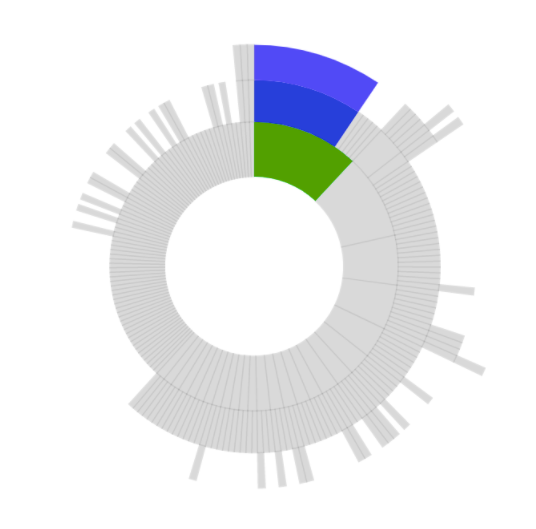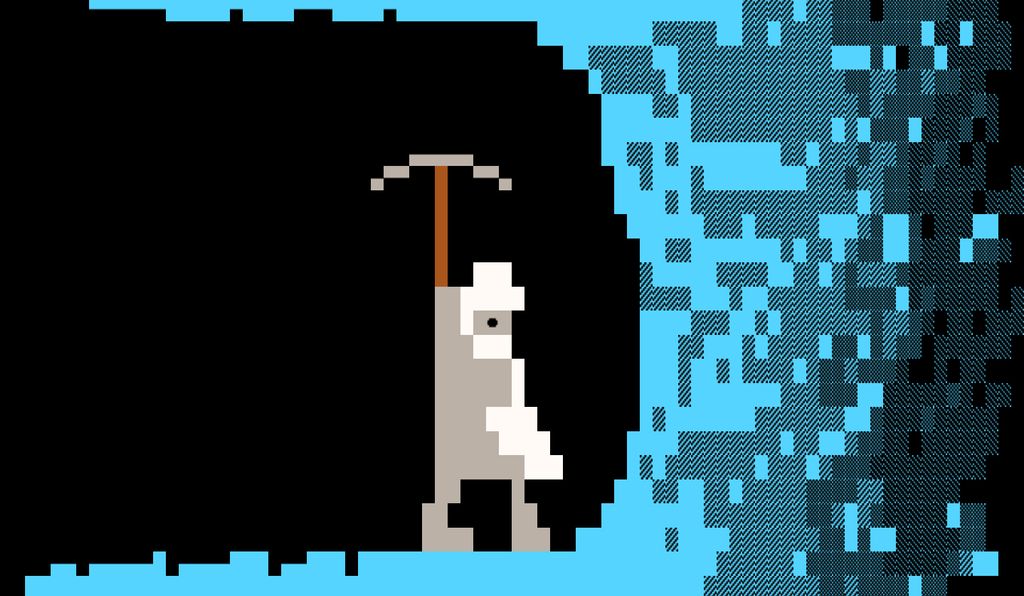Answer Set Programming: Into the Multiverse
What? Why?
- Practical logic programming
- Expressive; easy to model search problems
- Fast enough to be used in the Real World
Search problems?
Abstractly,
- A search space (and a way to navigate it)
- A goal
e.g. solving puzzles
- Search space: game states
- Goal: winning state

e.g. procedural generation
- Search space: all fully-connected maps
- Goal: a map traversable in n steps

A Map Generation Speedrun with Answer Set Programming, 2011
Answer Set Programming for Procedural Content Generation: A Design Space Approach, 2011
e.g. algorithmic composition
- Search space: all sequences of notes
- Goal: melodies which abide by the so-called “Palestrina rules” for Renaissance music
The composition of most styles of music is governed by rules... by formalising these rules in a suitable logical language, powerful and expressive intelligent composition tools can be easily built.
Automatic Music Composition using Answer Set Programming, 2010
e.g. dependency resolution
- Search space: all possible package configurations
- Goal: a set of package versions which satisfies all dependency constraints

e.g. PI Planning
- Search space: all possible plans (ticket-sprint assignments)
- Goal: a plan subject to lots of unspoken constraints…

“Optimized brute force”
Appropriate when:
- brute force is the best one can do (NP-hard)
- domain isn’t fully understood; rapid prototyping > asymptotics
- constraints are nontrivial and would eventually require search
Programming
“Generate and test”
- Define search space
- Remove unwanted parts
“Generate and Test”
Trial and error is also a heuristic method of problem solving, repair, tuning, or obtaining knowledge. In the field of computer science, the method is called generate and test (Brute force). In elementary algebra, when solving equations, it is guess and check.
“Guess and Check”
There are 15 puppies and birds at a pet shop. There are 42 legs altogether. How many puppies are there?
Facts
animal(puppy).
animal(bird).
legs(puppy,4).
legs(bird,2).
animal_n(1..15).
Rules
bipedal(A) :- animal(A), legs(A,2).
“A thing A is bipedal if it is a two-legged animal.”
Answer Sets
bipedal(A) :- animal(A), legs(A,2).
$ clingo animals.lp clingo version 5.4.0 Reading from animals.lp Solving... Answer: 1 animal_n(1) animal_n(2) animal_n(3) animal_n(4) animal_n(5) animal_n(6) animal_n(7) animal_n(8) animal_n(9) animal_n(10) animal_n(11) animal_n(12) animal_n(13) animal_n(14) animal_n(15) legs(puppy,4) legs(bird,2) animal(puppy) animal(bird) bipedal(bird) SATISFIABLE Models : 1 Calls : 1 Time : 0.024s (Solving: 0.00s 1st Model: 0.00s Unsat: 0.00s) CPU Time : 0.001s
Choice Rules
Define search space, or “possible worlds”:
animal(bird).
{ animal(puppy) }.
$ clingo animals.lp clingo version 5.4.0 Reading from animals.lp Solving... Answer: 1 animal(bird) Answer: 2 animal(bird) animal(puppy) SATISFIABLE Models : 2 Calls : 1 Time : 0.021s (Solving: 0.00s 1st Model: 0.00s Unsat: 0.00s) CPU Time : 0.001s

Choice Rules
Generate every possible pet shop… all \(2^{15}\) of them:
{ animal_at_shop(A, N) : animal(A) } = 1 :- animal_n(N).
SATISFIABLE Models : 32768 Calls : 1 Time : 3.294s (Solving: 3.27s 1st Model: 0.00s Unsat: 0.00s) CPU Time : 0.249s
Integrity Constraints
Remove possible worlds:
animal(bird).
{ animal(puppy) }.
:- animal(puppy).
$ clingo -n 0 animals.lp clingo version 5.4.0 Reading from animals.lp Solving... Answer: 1 animal(bird) SATISFIABLE Models : 1 Calls : 1 Time : 0.013s (Solving: 0.00s 1st Model: 0.00s Unsat: 0.00s) CPU Time : 0.001s
Integrity Constraints
Remove every world without the right number of legs:
correct_number_of_legs :- legs_total(42).
:- not correct_number_of_legs.
Aggregates
legs_total(L) :-
L = #sum { N,M : animal_at_shop(A, M), legs(A, N) }.
animal_count(A,N) :-
N = #count { M : animal_at_shop(A, M) }, animal(A).
Directives
#show animal_count/2.
#project animal_count(A,N).
#minimize { D : unassigned_count(D) }.
Putting it all together
animal(puppy;bird).
legs(puppy,4).
legs(bird,2).
animal_n(1..15).
{ animal_at_shop(A, N) : animal(A) } = 1 :- animal_n(N).
correct_number_of_legs :- legs_total(42).
:- not correct_number_of_legs.
legs_total(L) :- L = #sum { N,M : animal_at_shop(A, M), legs(A, N) }.
animal_count(A,N) :- N = #count { M : animal_at_shop(A, M) }, animal(A).
#show animal_count/2.
#project animal_count(A,N).
Running
$ clingo -n 0 animals.lp --project clingo version 5.4.0 Reading from animals.lp Solving... Answer: 1 animal_count(puppy,6) animal_count(bird,9) SATISFIABLE Models : 1 Calls : 1 Time : 0.271s (Solving: 0.26s 1st Model: 0.00s Unsat: 0.26s) CPU Time : 0.268s
“Generate and Test”
- Define search space using facts, rules, and aggregates
- Remove unwanted parts using integrity constraints
PI Planning + ASP

Facts
sprint(1..1).
story(1..2).
story_weight(2,1).
story_depends_on(1,2).
sprint_capacity(1,1).

Assignments
Each story is assigned to exactly one sprint:
{ assign(T,S) : sprint(S) } = 1 :- story(T).
Sprint Capacity
Sum story weights, grouping by assigned sprint:
sprint_total(S,To) :-
To = #sum { W,T : story_weight(T,W), assign(T,S) }, sprint(S).
Sprint Capacity
The sum of story weights cannot exceed sprint capacity, unless they’re unassigned:
sprint(unassigned).
:- sprint_total(S,A), sprint(S),
sprint_capacity(S,E), A > E, S != unassigned.
Optimization
unassigned_count(D) :- D = #count { T : assign(T,unassigned) }.
#minimize { D : unassigned_count(D) }.
Dependencies
Given a story dependency, the dependent story cannot be assigned to a later sprint than its dependency:
:- assign(T1,S1), assign(T2,S2),
story_depends_on(T1,T2), S1 < S2.
Pins
Story 1 must always be assigned to sprint 2:
:- not assign(1,2).
Design Choices
- Don’t solve for assignments globally
- Don’t solve on keypress…
- Where to run solver?
- Intuitiveness of assignments?
- Unstated constraints
Generating Stories

Generating Stories
Then suddenly, he was struck by a powerful but simple little truth, and it was this: That English grammar is governed by rules that are almost mathematical in their strictness! Given the words, and given the sense of what is to be said, then there is only one correct order in which those words can be arranged. Therefore, it stands to reason that an engine built along the lines of the electric computer could be adjusted to arrange words (instead of numbers) in their right order according to the rules of grammar. Then feed it with plots and leave it to write the sentences.
The Event Calculus
- Logical representation of actions and their effects
- “How do we represent time?”
Key ideas
- Index rules by time
- Keep track of events which happen
- Keep track of the effects of events, i.e. what is now known about the world
Time
#const t_max=15.
time(0..t_max).
- Abstract unit of time
- Simulate
t_maxtime points
Events
Events happen only under specific conditions
{ happens(T,E) } :- time(T), possible(T,E).
Only one event happens at a time
:- time(T), not { happens(T,E) } = 1.
Effects of Events
Facts hold as a result of things happening
initiated(T,F) :- happens(T,E), initiates(T,E,F).
holds(T+1,F) :- time(T), happens(T,E), initiates(T,E,F).
Facts are inertial; they continue to hold without external influence
terminated(T,F) :- happens(T,E), terminates(T,E,F).
holds(T+1,F) :- time(T), holds(T,F), not terminated(T,F).
Authoring
- Events:
possible,initiates,terminates - Static knowledge
- Dynamic knowledge
- Constraints
Let’s make a Disney movie

Static Knowledge
character(rey).
character(kylo).
character(palpatine).
Places
place(pasaana).
place(kijimi).
place(endor).
place(exegol).
place(resistance_base).
place(tatooine).
always_reachable(resistance_base,pasaana).
always_reachable(pasaana,kijimi).
always_reachable(kijimi,endor).
always_reachable(exegol,endor).
always_reachable(exegol,kijimi).
always_reachable(exegol,tatooine).
Dynamic Knowledge
holds(0,reachable(P1,P2)) :- always_reachable(P1,P2),
place(P1), place(P2).
Dynamic Knowledge
holds(0,at(kylo,exegol)).
holds(0,at(rey,resistance_base)).
holds(0,at(palpatine,exegol)).
holds(0,alive(C)) :- character(C).
Moving around
possible(T,moves(C,P1,P2)) :-
holds(T,at(C,P1)), not holds(T,at(C,P2)),
holds(T,reachable(P1,P2)),
holds(T,alive(C)),
character(C), place(P1), place(P2).
initiates(T,moves(C,P1,P2),at(C,P2)) :-
possible(T,moves(C,P1,P2)).
terminates(T,moves(C,P1,P2),at(C,P1)) :-
possible(T,moves(C,P1,P2)).
Trying it out
$ clingo disney.lp
clingo version 5.4.0
Reading from disney.lp
Solving...
Answer: 1
happens(0,moves(kylo,exegol,pasaana)) happens(2,moves(rey,resistance_base,pasaana)) happens(3,moves(palpatine,exegol,tatooine)) happens(1,moves(kylo,pasaana,endor)) happens(4,moves(kylo,endor,tatooine)) happens(5,moves(kylo,tatooine,exegol))
SATISFIABLE
Models : 1+
Calls : 1
Time : 0.021s (Solving: 0.00s 1st Model: 0.00s Unsat: 0.00s)
CPU Time : 0.021s
Trying it out
happens(0,moves(rey,resistance_base,pasaana))
happens(1,moves(rey,pasaana,kijimi))
happens(2,moves(rey,kijimi,endor))
happens(3,moves(palpatine,exegol,kijimi))
happens(4,moves(kylo,exegol,kijimi))
happens(5,moves(palpatine,kijimi,endor))
Wayfinding
item(wayfinder).
holds(0,has(endor,wayfinder)).
possible(T,finds(C,I,P)) :-
holds(T,at(C,P)),
not holds(T,has(C,I)), holds(T,has(P,I)),
holds(T,alive(C)),
character(C), item(I), place(P), time(T).
initiates(T,finds(C,I,P),has(C,I)) :- possible(T,finds(C,I,P)).
terminates(T,finds(C,I,P),has(P,I)) :- possible(T,finds(C,I,P)).
Wayfinding
happens(0,moves(kylo,exegol,endor))
happens(1,moves(palpatine,exegol,endor))
happens(2,finds(palpatine,wayfinder,endor))
happens(3,moves(rey,resistance_base,pasaana))
MacGuffins
holds(T,reachable(P,exegol)) :-
holds(T-1, has(rey,wayfinder)), time(T), place(P).
No one goes into Exegol until then…
MacGuffins
happens(0,moves(rey,resistance_base,pasaana))
happens(1,moves(rey,pasaana,kijimi))
happens(2,moves(rey,kijimi,endor))
happens(3,finds(rey,wayfinder,endor))
happens(4,moves(palpatine,exegol,endor))
happens(5,moves(rey,endor,exegol))
Not from a Jedi
side(light).
side(dark).
holds(0,alignment(rey,light)).
holds(0,alignment(kylo,dark)).
holds(0,alignment(palpatine,dark)).
Not from a Jedi
possible(T,turns(C1,C2,S1,S2)) :-
holds(T,alignment(C2,S1)), not holds(T,alignment(C2,S2)),
holds(T,at(C1,P)), holds(T,at(C2,P)),
holds(T,alignment(C1,S2)),
holds(T,alive(C1)), holds(T,alive(C2)),
place(P), character(C1), character(C2), side(S1), side(S2).
initiates(T,turns(C1,C2,S1,S2),alignment(C2,S2)) :-
possible(T,turns(C1,C2,S1,S2)).
terminates(T,turns(C1,C2,S1,S2),alignment(C2,S1)) :-
possible(T,turns(C1,C2,S1,S2)).
Not from a Jedi
happens(0,moves(rey,resistance_base,pasaana))
happens(1,moves(rey,pasaana,kijimi))
happens(2,moves(rey,kijimi,endor))
happens(3,moves(palpatine,exegol,endor))
happens(4,moves(kylo,exegol,endor))
happens(5,turns(palpatine,rey,light,dark))
Lightsabers
possible(T,lightsaber_duel(C1,C2)) :-
C1 != C2,
holds(T,alignment(C1,S1)), holds(T,alignment(C2,S2)), S1 != S2,
holds(T,at(C1,P)), holds(T,at(C2,P)),
holds(T,alive(C1)), holds(T,alive(C2)),
place(P), character(C1), character(C2),
side(S1), side(S2), time(T).
terminates(T,lightsaber_duel(C1,C2),alive(C2)) :-
possible(T,lightsaber_duel(C1,C2)).
Lightsabers
climax :- happens(T,lightsaber_duel(C1,C2)),
character(C1), character(C2).
:- not climax.
rey_reaches_exegol :- holds(t_max+1,at(rey,exegol)).
:- not rey_reaches_exegol.
turn :- happens(T,turns(C1,C2,S1,S2)),
character(C1), character(C2), side(S1), side(S2).
:- not turn.
Lightsabers
happens(0,moves(rey,resistance_base,pasaana))
happens(1,moves(kylo,exegol,kijimi))
happens(2,moves(rey,pasaana,kijimi))
happens(3,moves(palpatine,exegol,kijimi))
happens(4,turns(rey,palpatine,dark,light))
happens(5,lightsaber_duel(rey,kylo))
Plot Point Reversal
{ pick_reason(T,plot_point_reversal(C,R)) : reason(R) } = 1 :-
character(C), time(T).
possible(T,plot_point_reversal(C,R)) :-
not holds(T,alive(C)),
pick_reason(T,plot_point_reversal(C,R)),
place(P), character(C), time(T).
initiates(T,plot_point_reversal(C,R),alive(C)) :-
possible(T,plot_point_reversal(C,R)).
Plot Point Reversal
anticlimax :- happens(T,plot_point_reversal(C,R)),
character(C), reason(R).
:- not anticlimax.
Generated Plot
happens(0,moves(palpatine,exegol,tatooine))
happens(1,moves(kylo,exegol,endor))
happens(2,moves(rey,resistance_base,pasaana))
happens(3,moves(rey,pasaana,kijimi))
happens(4,moves(rey,kijimi,endor))
happens(5,lightsaber_duel(kylo,rey))
happens(6,plot_point_reversal(rey,it_was_all_a_dream))
happens(7,lightsaber_duel(kylo,rey))
happens(8,plot_point_reversal(rey,the_dark_side_of_the_force_is_a_pathway_to_many_abilities_some_consider_to_be_unnatural))
happens(9,finds(rey,wayfinder,endor))
happens(10,turns(rey,kylo,dark,light))
happens(11,moves(kylo,endor,exegol))
happens(12,moves(kylo,exegol,tatooine))
happens(13,lightsaber_duel(palpatine,kylo))
happens(14,moves(rey,endor,exegol))
happens(15,moves(palpatine,tatooine,exegol))
Another
happens(0,moves(rey,resistance_base,pasaana))
happens(1,moves(rey,pasaana,kijimi))
happens(2,moves(rey,kijimi,endor))
happens(3,finds(rey,wayfinder,endor))
happens(4,moves(kylo,exegol,endor))
happens(5,moves(rey,endor,exegol))
happens(6,moves(rey,exegol,kijimi))
happens(7,moves(rey,kijimi,exegol))
happens(8,moves(kylo,endor,exegol))
happens(9,lightsaber_duel(rey,kylo))
happens(10,lightsaber_duel(rey,palpatine))
happens(11,plot_point_reversal(kylo,it_was_a_hologram))
happens(12,moves(rey,exegol,tatooine))
happens(13,plot_point_reversal(palpatine,it_was_a_hologram))
happens(14,moves(rey,tatooine,exegol))
happens(15,turns(rey,palpatine,dark,light))
Story generation + ASP
- Tabula rasa generation: explore plot space
- Constrained generation: touch on given plot points
- Finish a partial story
RoleModel: Towards a Formal Model of Dramatic Roles for Story Generation
Can we really generate stories?
Yes, but expect lots of writing...
PCG promises a free lunch.
— Kate Compton, actual doctor of weird ai (@GalaxyKate) March 9, 2020
It delivers an angry cow and a small knife, and a promise that if you can make this work, you'll eat like a king.
Potpourri
- Performance
- Random sampling
- Debugging
- Ecosystem
clingo runs forever!
- Variables are replaced with concrete values before any solving starts (“grounding”)
- Wide relations will cause blowup
- Denormalize
- More efficient encodings
Random sampling
--rand-freq=1 --seed=39403
Debugging
Solving... UNSATISFIABLE Models : 0
Debugging
Removing a goal can make a predicate at most more general, never more specific.
Debugging
- Bisect program!
- Give names to integrity constraints so invalid worlds can be inspected
- Unfortunately, have to modify program
Ecosystem
- Unit tests: AnsUnit
- ORM: clorm
- IDE: SeaLion
- Visualization toolkit: Possible Worlds Explorer
- PCG: Ex Nihilo

Limitations
“Declarative”
- Small changes can drastically affect performance
- Correctness is not obvious
- Translations of imperative concepts can be difficult
- Unfamiliar
Black box
- By design
- Efficient encodings are hard for non-experts
- No e.g. global constraints
Reflection
- Useful for a class of problems
- Rapid prototyping
- Nice formalism that works in practice